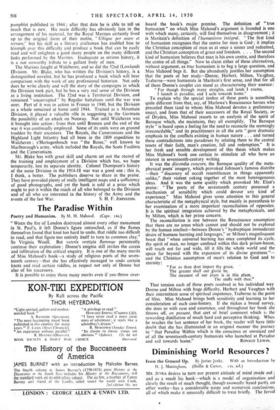Esprit de Corps
SIR ROBERT BRUCE LOCKHART tells the story of a recruit at a Marine depot who, suddenly asked by the commanding officer to
repeat the motto of the Royal Marines, could think of no better reply than " Esprit de corps." It is certainly a quality which has played a great part in the history of the fighting services. Loyalty tends to be given to the part rather than to the whole, although this century has seen something of an increase in the size of the part which is able to attract the loyalty and affection of its members. The First World War saw the development of divisional loyalty ; during the Second, in the case of the Eighth and Fourteenth Armies at least, we have seen the rise of a loyalty to an even larger formation. The essence of loyalty, however, is continuity, and in modern conditions continuity, difficult enough to maintain for small units, is almost impossible ot attainment for larger formations.
Loyalty, however, is being expressed and traditions maintained in the spate of unit and formation histories which is now pouring from the Press as in the years after 1919. These histories tend to fall into three groups. First, there are those written by combatants ; such histories have an obvious value as conftmporary records. Then there are those written by literary men or journalists on the basis of information supplied to them. Finally, there are those written by professional military historians, which are often of great value to serious students of war.
The first of the books reviewed here belongs to the second cate- gory. Sir Robert Bruce Lockhart has written an attractive and discursive account of the part played by the Royal Marines in the late war. His point of contact with the Corps was somewhat accidental, arising out of his association with General Sir Dallas Brooks in the Political Warfare Executive, but he has taken great pains to make himself familiar with Marine customs and traditions. For the period up to 1943 he has leaned heavily on the Admiralty
pamphlet published in 1944 ; after that date he is able to tell us much that is new. His main difficulty has obviously lain in the arrangement of his material, for the Royal Marines certainly lived up to the original form of their motto, " Ubique per mare et terram," but his skill as a literary craftsman has enabled him to triumph over this difficulty and produce a book that can be easily read and will enlighten a good many people on the many different tasks performed by the Marines. Inadequate as serious history, it is a not unworthy tribute to a gallant body of men.
The Marines fought at Walcheren, and so did the 52nd (Lowland) Division. Mr. Blake, who has written the Division's history, is a distinguished novelist, but he has produced a book which will bear comparison with the work of any professional historian. Not only does he write clearly and well the story of the campaigns in which the Division took part, but he has a very real sense of the Division as a living institution. The 52nd was a Territorial Division, and remained " uncorrupted " by Regular battalions until the war was over. Part of it was in action in France in 1940, but the Division as a whole remained at home until 1944. Trained as a Mountain Division, it played a valuable role in suggesting to the Germans the possibility of an attack on Noway. Not until Walcheren was it brought into action ; from then until Bremen and the end of the war it was continually employed. Some of its units were on ground trodden by their ancestors. The Royals, the Cameronians and the Highland Light Infantry had all been in the 1809 expedition to Walcheren ; s'Hertogenbosch was " the Busse," well known to Marlborough's army, which included the Royals, the Scots Fusiliers and the Cameronians.
Mr. Blake has with great skill and charm set out the record of the training and employment of a Division which has, we hope temporarily, lost its separate identity. Colonel Thompson's history of the same Division in the 1914-18 war was a good one ; this is, I think, a better. The publishers deserve to share in the praise. They have provided plenty of really intelligent maps and a sufficiency of good photographs, and yet the book is sold at a price which ought to put it within the reach of all who belonged to the Division and of all who are interested in the history of the Army and the







































 Previous page
Previous page